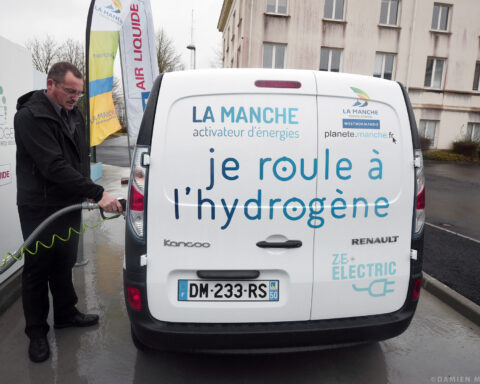Steel and other energy-intensive industries run on the planet’s second most important source of power: green hydrogen, an almost magically clean fuel made by electrolysing water using renewable electricity to separate out the hydrogen atoms. Its only by-product is oxygen.
The transformative power of green hydrogen is the vision inspiring the current generation of politicians and planners as they plan a decarbonised 2050. Even if renewable electricity is at the centre of these plans, there remains a need for other fuels to power heavy industry.
As EBRD hydrogen coordinator Cristian Carraretto puts it, “you don’t really achieve high temperatures with electricity, not yet at least; the only way is to have a fuel.” Enter hydrogen, which can serve as an energy carrier or as feedstock. It can be used to store seasonal renewable electricity. As well as its potential for decarbonising sectors such as steel (it can serve as green fuel for heavy-duty transport – long-distance lorries – which do not work with today’s electric battery technologies.
There is some way to go. Today, most hydrogen is still not green but produced from fossil fuels such as coal or gas. Green hydrogen, which today costs 50 per cent more to produce than fossil-fuel hydrogen, so far only accounts for a couple of per cent of global use, currently at around 70 million tonnes a year.
Yet, Mr Carraretto adds, “A number of institutions including the International Energy Agency expect the level of hydrogen use to grow from 70 million tonnes to more than 500 million tonnes a year by 2050. This will not happen at once, of course. But it looks like it might at least double by 2030.”
The good news is that a rapid drop in wind, solar and battery costs in recent years has already enabled an accelerated rollout of renewables, making solar- and wind-generated electricity cheaper than gas in many countries.
With the renewable energy that will power the hydrogen revolution becoming so much more affordable so fast, investment is pouring into building ever more renewables capacity. Using this electricity to produce green hydrogen at the required scale is looking ever more plausible.
The dramatic difference the growth of affordable renewables is already making – and the potential for change it brings – is brought out by a May report by Carbon Tracker Initiative, showing that the world’s solar and wind energy potential exceeds global energy demand by as much as 100 times.
Green hydrogen sceptics sometimes argue that an unacceptable amount of land would have to be sacrificed to solar panels to create adequate renewable electricity to power the future green hydrogen industry. But this report says land is no constraint: “the land required for solar panels alone to provide all global energy is 450,000 km2, 0.3 per cent of the global land area of 149 million km2. That is less than the land required for fossil fuels today.”
The revolutionary potential of clean hydrogen (a category that includes both green hydrogen and blue hydrogen, made from gas, which does generate emissions, but ones which are then neutralised by being captured and stored) has been understood for years.
General Motors built a hydrogen-powered vehicle in the 1960s. Man landed on the moon with hydrogen-powered rockets. Developing the technology proved expensive and complex. But the 2015 Paris climate agreement, in which countries pledged to reduce emissions to net zero by mid-century so as to keep temperature rises well below 2C, has brought clean and green hydrogen back to the fore as governments grapple with how to clean up the most polluting parts of their economies.
Despite the potential, however, this is an industry still at its very beginning. It will take time for green hydrogen technology to be adopted more widely – with gas providers learning how to pipe increasing amounts of hydrogen through existing natural gas pipelines, and companies building production hubs and adapting to hydrogen use.
Likewise, however fast renewable energy capacity grows, not enough renewable electricity is yet being produced both to decarbonise electricity systems and to produce a full supply of green hydrogen. “The issue is, do we want to give priority to hydrogen or do we want to give priority to electricity?” Mr Carraretto says. “The answer at the end is both. But we need to be pragmatic.”
Experts envisage a transitional period where increasing amounts of hydrogen are used to power industry, but initially it is at least partly made from fossil fuels. As the goal of producing enough renewable electricity to power the creation of green hydrogen comes closer, attention is turning to the practicalities of making green hydrogen.
Some adventurous producers are already beginning to manufacture green hydrogen. In Europe, the Hybrit project in northern Sweden uses renewable electricity hydrogen to produce carbon-free steel, and a 6 megawatt electrolyser developed under the EU-funded H2 project supplies green hydrogen to a steel plant in Austria. On a grander scale, a Dubai-based project described as the “first industrial scale, solar-driven green hydrogen facility in the Middle East and North Africa” was inaugurated in May 2021, funded by Siemens Energy, the Dubai Electricity and Water Authority and Expo 2020 Dubai.
Advanced-economy areas such as the European Union, which already have ambitious hydrogen strategies in place as part of their decarbonisation push, are leading the way in promoting hydrogen. But, Mr Carraretto says, neighbouring countries – not least those in the EBRD regions of central and eastern Europe, Central Asia, and the southern and eastern Mediterranean – could be in “an extremely good position to react very quickly.”
“Regionally Europe is very active, and a large part of the demand for hydrogen will grow in Europe. Then the question becomes, what about the neighbouring countries? They might be driven to do something similar because of the market in Europe: producers in nearby countries might consider producing hydrogen and selling it to Europe, for example.”
Officials and companies in several EBRD countries are already readying themselves. The EBRD is supporting Georgia in its quest to explore the country’s potential for generating green hydrogen using its vast water resources. Turkey held a 2020 hydrogen conference, and Morocco, a regional leader in developing renewable energy, was cited by Germany’s Ministry of Economic Cooperation and Development as the potential source of up to four per cent of the global demand for green hydrogen by 2030.
As Carbon Tracker Initiative’s hydrogen report points out, “poor countries are the greatest beneficiaries”. “They have the largest ratio of solar and wind potential to energy demand, and stand to unlock huge domestic benefits. The continent of Africa for example is a renewables superpower, with 39 per cent of global potential.”
Building the necessary green hydrogen production facilities to use this energy potential to the full might be expensive for a low- or middle-income country, but Mr Carraretto comments that oil-producing nations all made similar necessary investments in their time.
He is concerned that hot and windy countries should do more than simply export the energy they produce to wealthy nations and regions. They should take full advantage of the domestic development potential that both renewable electricity and green hydrogen production can bring them, he says.
“This is a technology that is going to show the EBRD regions in a very good light. The parallel that comes to mind is the Middle East or the North Sea oil wealth of previous generations. This is an opportunity for parts of the EBRD regions that are already developing solar or wind power to become hydrogen-rich too.”




